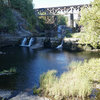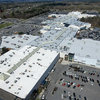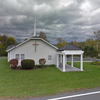ldquo Miraculous rdquo
School taxes to go down
GUILDERLAND For the first time in memory, school tax rates for Guilderland residents will go down.
In a 6-to-1 vote Tuesday night, the school board decided on a tax rate of $19.34 per $1,000 of assessed value, down about three cents from last year.
Board member Denise Eisele said that people she had told about the decrease used the word “miraculous” to describe it. “What a wonderful gift to the community,” she said.
When voters went to the polls in May, passing the $85 million budget, they were given an estimated tax increase of .58 percent, which would have meant Guilderland residents would pay $19.49 per $1,000 of assessed value.
The district was able to implement the decrease because property assessments in the town of Guilderland went up $23 million from last year. Assistant Superintendent for Business Neil Sanders told The Enterprise that he had figured assessments would be flat. The taxable valuation for Guilderland is $2.75 billion.
Guilderland’s assessor, John Macejka, said yesterday that he takes a conservative approach when estimating assessment growth as school districts check with him early in the budget process.
“It’s a snapshot in time,” he said, explaining that, since certiorari matters are outstanding and assessments haven’t been completed, he’d rather make a flat estimate than have the five school districts in the town of Guilderland relying on more funds than they may get. “I find it’s the fairest way for the taxpayer,” he said. “I don’t like to see raises in taxes.”
Asked what, specifically, caused the $23 million increase, Macejka said, “We had quite a bit of construction, not necessarily new.” This included commercial construction as well as homeowners’ adding swimming pools or seasonal rooms, all of which add value.
New buildings added to the tax rolls included the Woodsfield subdivision off of Lydius Street, Troy Miller’s building center on Western Avenue, the SEFCU bank in Altamont, and Jeff Thomas’s Brandle Meadows condominiums outside of Altamont, he said.
“In spite of what people might think of the economy in the Capital Region, Guilderand helds its own,” said Macejka. “We were fortunate.”
Lone voice of caution
As the school board prepared to set the tax rate Tuesday, Sanders presented two plans the plan with the .18-percent decrease that the board ultimately adopted and another plan that would have left the tax rate as it had been estimated, with a .58-percent increase. “The advantage is we could put some more money aside in these difficult times,” said Sanders.
The district recommended decreasing taxes. “In most every other year in my professional life, I would have lobbied on let’s...cushion our safety net, put it in our fund balance,” said Superintendent John McGuire. But, he said, since district reserves were “quite healthy” and times are tough, he recommended passing the savings on to the community.
Julie Cuneo, who was elected in May, was the only board member to favor the plan that would have set aside more savings. She cited “uncertain financial times,” not knowing what the state budget will allow in school aid, and also district goals for the upcoming year in supporting teachers and teachers’ aids.
“We’re still meeting the taxpayers’ expectations,” Cuneo said of at .58-percent increase as predicted before the May budget vote.
While the lion’s share of the school district is in the town of Guilderland, pieces of it lie in three other towns. Because assessment practices vary from town to town, the state sets an equalization rate so that residents with like properties, regardless of which town they live in, are paying the same amount in taxes.
Residents of Bethlehem, where the equalization rate is 93 percent, who live in the Guilderland School District will pay $16.45 per $1,000 of assessed valuation, a decrease of 24 cents or 1.43 percent from last year.
Residents of New Scotland, where the equalization rate is 94 percent, will pay $16.27, which is 14 cents less than last year, a decrease of .84 percent.
And residents of Knox, where the equalization rate is 50 percent since the town hasn’t reassessed for years, will pay $30.59, an increase of $1.49 or 5.11 percent over last year.


